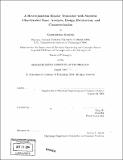| dc.contributor.advisor | Qing Hu. | en_US |
| dc.contributor.author | Konistis, Konstantinos, 1973- | en_US |
| dc.contributor.other | Massachusetts Institute of Technology. Dept. of Electrical Engineering and Computer Science. | en_US |
| dc.date.accessioned | 2005-09-27T17:55:47Z | |
| dc.date.available | 2005-09-27T17:55:47Z | |
| dc.date.copyright | 2004 | en_US |
| dc.date.issued | 2004 | en_US |
| dc.identifier.uri | http://hdl.handle.net/1721.1/28712 | |
| dc.description | Thesis (Ph. D.)--Massachusetts Institute of Technology, Dept. of Electrical Engineering and Computer Science, 2004. | en_US |
| dc.description | Includes bibliographical references (p. 117-126). | en_US |
| dc.description.abstract | (cont.) features but the device self-heating turned out to be crucial for the longevity of the base micro-airbridges. The short lifetime of the base micro-airbridges was prohibitive for the realization of high frequency measurements. This work serves as the foundation for the implementation of robust HBT transit-time oscillators with the incorporation of slight modifications in the fabrication process. | en_US |
| dc.description.abstract | This thesis explores the potential benefits of a GaAs-based heterojunction bipolar transistor (HBT) with stepwise alloy-graded base. The step height is slightly greater than the longitidinal optical (LO) phonon energy h[omega]LO in order to facilitate LO-phonon-enhanced forward diffusion of minority carriers in the base. The intuitive theoretical approach of carrier transport in the base, as proposed by other workers for this type of alloy-grading, did not incorporate in detail the various mechanisms of transport. In this work, we solved the Botzmann transport equation (BTE) in one dimension across the base for arbritrary frequencies. Impurity and LO phonon scattering were considered as the dominant scattering mechanisms. The intrinsic and extrinsic elements were combined and a small-signal equivalent circuit was proposed for the evaluation of the high-frequency performance of the device. The unique feature of this HBT is that the base transport factor undergoes a moderate magnitude attenuation and phase delay. By choosing a suitable collector delay, a band-limited negative output resistance can emerge in the microwave/millimeter-wave regime. The main benefit of the device is its inherent property as a transit-time high-frequency oscillator. Using our device simulator, we selected the material parameters for epitaxial growth (MBE) of the device wafer and we investigated various device layouts. We implemented the complete microfabrication of 2 [micro]m x 15 [micro]m, self-aligned, emitter-up HBTs with micro-airbridges for device isolation purposes. We performed DC measurements of various devices and they provided us with feedback for modifications in the MBE design and growth conditions of the device wafer. We finally fabricated HBTs with favorable DC | en_US |
| dc.description.statementofresponsibility | by Konstantinos Konistis. | en_US |
| dc.format.extent | 126 p. | en_US |
| dc.format.extent | 7006227 bytes | |
| dc.format.extent | 7022058 bytes | |
| dc.format.mimetype | application/pdf | |
| dc.format.mimetype | application/pdf | |
| dc.language.iso | en_US | |
| dc.publisher | Massachusetts Institute of Technology | en_US |
| dc.rights | M.I.T. theses are protected by copyright. They may be viewed from this source for any purpose, but reproduction or distribution in any format is prohibited without written permission. See provided URL for inquiries about permission. | en_US |
| dc.rights.uri | http://dspace.mit.edu/handle/1721.1/7582 | |
| dc.subject | Electrical Engineering and Computer Science. | en_US |
| dc.title | A heterojunction bipolar transistor with stepwise allog-graded base : analysis, design, fabrication, and characterization | en_US |
| dc.type | Thesis | en_US |
| dc.description.degree | Ph.D. | en_US |
| dc.contributor.department | Massachusetts Institute of Technology. Department of Electrical Engineering and Computer Science | |
| dc.identifier.oclc | 59552651 | en_US |
